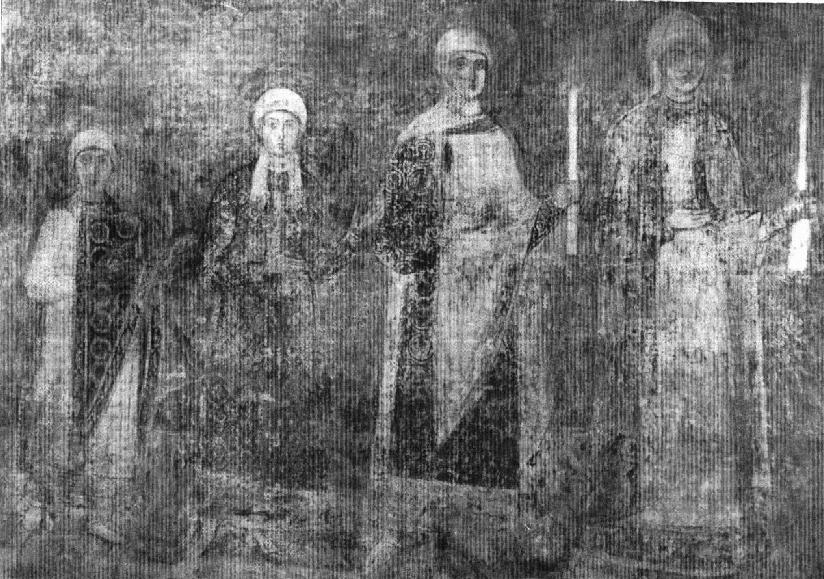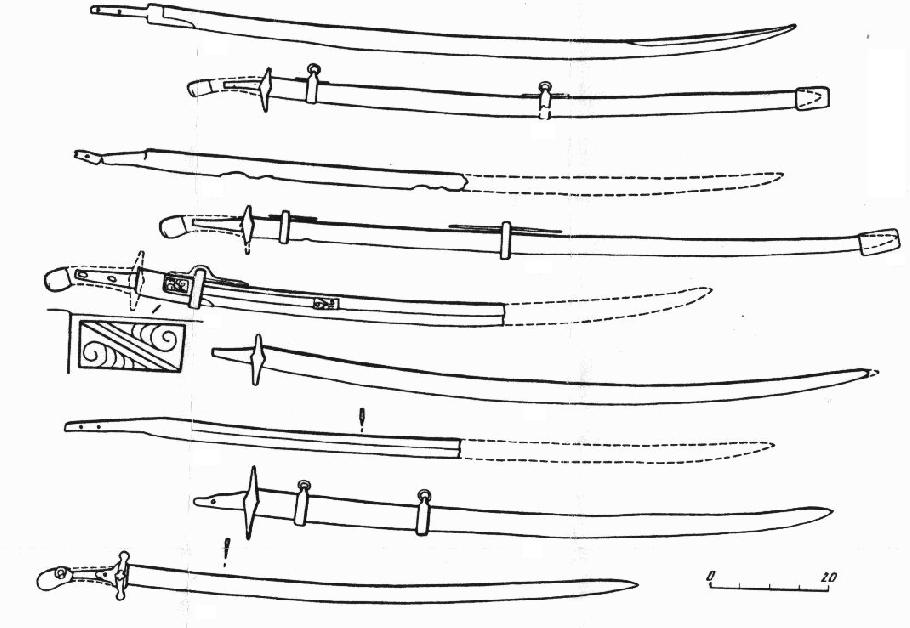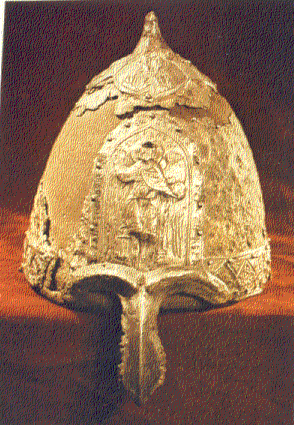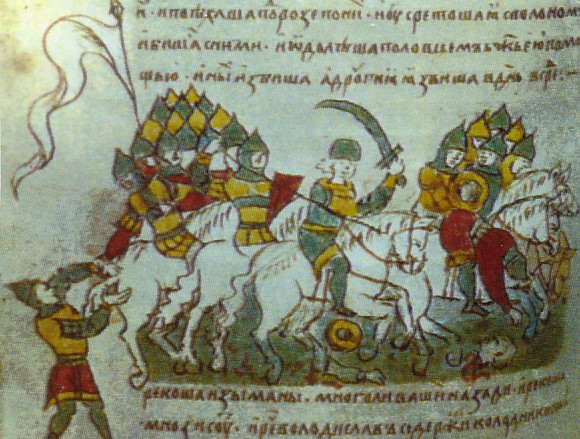THE VIKINGS IN RUSSIA
Steven Lowe
The Vikings came to Russia through the trade routes from Sweden down the Russian rivers, particularly the Don and the Dnieper, which led south to the markets of Bulgar, Khazaria, Byzantium and the Caliphate. Some reached as far East as the Caspian Sea and as far south as Baghdad. They traded amber, furs, honey, slaves, wax and weapons, for the luxuries of civilization, silk and silver (large hoards of Arab dirhems have been found throughout Scandinavia.) They founded the great cities of Starja Ladoga, Kiev and Novgorod.
They were known as Rus, a name whose origins are the subject of some controversy. The majority view seems to be that it is a Finnish name for the Vikings of Sweden, but it seems to have ended up being used to describe all Russians, whether Norse or Slavic. The earliest mention of the name is in the Frankish Chronicles of St Bertin, where emissaries of the Svear (Swedish) people appeared in the court of Louis the Pious (son of Charlemagne). They had travelled from Byzantium, and asked for safe conduct home to Scandinavia, as the danger of attack by the tribes on the Russian rivers had made it impossible to return the way they had come. Louis was subject to attacks from the Vikings, and regarded these people as possible spies. The Rus were certainly in the region as early as the beginning of the 9th century. According to the Russian Primary Chronicle, compiled in Kiev in the early 12th century, the Slavs invited the Swedish chieftain Rurik and his two brothers to rule them in 862 AD. In fact, the Rus seem to have kept mainly to the regions along the rivers - their relations with the Slavs being mostly confined to exacting tribute and raiding for slaves. Among their neighbours was the empire of the Khazars, stretching around the Black Sea from the Danube to the Caspian. The Khazars were a Turkic race who had been converted to Judaism in the 8th century AD, and according to some sources were the overlords of the Rus. The Rus were described in 922 by the Arab diplomat Ibn Fadlan thus: “Never before have I seen people of more perfect physique. They are tall as date-palms, blonde and ruddy.” (Roesdahl, 1991) However, he also said of them: They are the filthiest of Allah’s creatures; they do not wash after shitting and peeing, nor after sexual intercourse, and do not wash after eating. They are like wayward donkeys” (Ibid.) According to Ibn Fadlan, the Rus he encountered did wash once a day, but all used the same water, and their ablutions included spitting and blowing their noses into the communal washbowl and handing it to the next person. He may have been exaggerating to shock his fastidious Arab audience. After all, the Anglo-Saxons at about the same time were railing against their own people taking up the effeminate Viking practices of washing and combing their hair. Or maybe this is a comment on how much worse the English were! The Rus in Ibn Fadlan’s time were followers of the pagan Scandinavian gods. He describes their burial practices, involving animal and human sacrifice, and the funeral pyre of a chieftain in his longship. One Rus explained to him that cremation was much better than the Muslim custom of burial, saying “We burn him in fire in a moment, and he goes at once to paradise.” (Ibid.) Ibn Fadlan also describes the Rus habit of imbibing great quantities of nabid, an unspecified alcoholic drink, and said that they were often found dead still grasping a beaker of it. The Rus were also known as Varangians - a term which is thought to come from a Norse word meaning those who join in an oath, probably to share the takings of their trading. It was later extended to mean the Norsemen of Russia as a group, and came to include Slavs, Anglo-Saxons and others. The Dnieper route involved negotiating seven rapids, through some of which the boats could be dragged, but in others the vessels had to be bodily lifted from the water and hauled overland to where the river could safely be entered again. There was also the danger of attack from antagonistic tribes living along the rivers, particularly the Turkic Pechenegs. In the 10th and 11th centuries the Rus alternated between trading with Byzantium and attacking it. In 907 and 1043 fleets were entirely destroyed before the walls of Constantinople by the Byzantine secret weapon, Greek fire, and an attack in 960 was also turned back. Around 965 Tsar Svyatoslav of Kiev attacked the empire of the Khazars, capturing the capital, Atil. The Khazars withdrew from the Caspian region, defending themselves on the Bosphorus coast of what is now north-western Turkey. (They survived there in a much diminished form until 1016 when the Rus combined with Byzantium to destroy the remnants of the Khazar empire.) About the same time Bulgarian Kijnaz (king) Symeon demanded the reinstatement of an earlier tribute Byzantium had paid to his forebears. Emperor Nicephoros Phocas, professing himself highly insulted, bribed the Russians of Kiev to attack Bulgaria. In 967 Svyatoslav crossed the Danube with 16,000 men and with Imperial ambassador Kalokyras as a guide, stormed through Bulgaria to Thrace. But Kalokyras, with an army of Rus at his back, decided to make his own bid to become emperor. Svyatoslav sent insolent messages to Constantinople, ordering the Byzantines out of Europe unless an enormous tribute was paid. Nicephoros, having lost control of the situation was assassinated by his wife and her lover, general John Tzimiskes. In 977, at the head of a large and well trained army, Tzimiskes set out on one of the most brilliant campaigns of Byzantine military history. In April he took Great Preslav from the Russians after a furious battle and besieged them in Silesia for three months. The Russians capitulated, and pledged never again to attack Byzantium or Bulgaria, in return for freedom to return to Kiev. But on the way home they were ambushed and slaughtered by Pechenegs, and Svyatoslav’s skull was reputedly made into a drinking vessel. In 988, as part of a treaty involving marriage to a Byzantine princess, and the ceding of some Byzantine territory, Kievan Tsar Vladimir (from Swedish Valdemar) agreed to convert to Christianity. It is said that he had compared the various religious choices available, dismissing Islam because of its prohibition on alcohol, and deciding on Orthodox Christianity because of the splendor of its churches and ceremonial. The Russian people were forcibly converted to Christianity, but Vladimir kept the liturgy in Slavic Russian rather than Greek, which helped enable him to maintain independence of Byzantium. Vladimir had recently used 6000 warriors imported from Sweden to put down an insurrection, and he now had an army on his hands with nothing to do. As part of the treaty, he sent them to Byzantium, where they became the first Varangian Guards . Vladimir’s son Jaroslav the Wise married the Swedish princess Ingegerd, and all his children married into royalty. One daughter became the Queen of Hungary, another Queen of France, while his eldest married the Norwegian King, Harald Hardrada. The cities of Russia became filled with magnificent cathedrals, and Byzantine culture had a marked effect on the country. There was a continual movement of Scandinavians through Russia from the ninth to the 12th centuries, and considerable cultural interchange between the two regions. However, the decline of the trade routes through Byzantium, and an apparent exhaustion of the Arab silver mines caused the importance of the cities of Kiev and Novgorod to lessen. From the 11th to the 13th centuries there were dynastic wars between the under-princes subject to Kiev, and when Prince Andrei Bogolyubsky captured Kiev in 1169 he moved the capital to his new city of Vladimir. The Rus intermarried with the subject Slavs and took on their customs to such an extent that though they were still ruled by the descendants of Rurik, they had practically ceased to exist as a separate race by the 13th century.
Fig. 1 : The 1169 AD battle between Novgorod and Suzdal. Russia Under the Czars, H. Moscow and C. Black, Cassell, London 1962
Between 1237 and 1240 the Russian state was swallowed up by the Mongols under Batu Khan. Kiev and the other great cities fell, and their populations were put to the sword. Only Novgorod survived. The Kievan Russians lived on as Mongol vassals. Invasions by the Swedes and the Teutonic Knights of Germany in the 13th century were resisted by Russian princes, one of the best known being Aleksandr Nevski, the son of the Grand Duke of Novgorod. He defeated the Swedes on the Neva River in 1240, and in alliance with the Mongols in 1242 he destroyed an army of Teutonic Knights on the frozen surface of Lake Peipus. In 1380, the newly emerged principality of Muscovy (based in Moscow) defeated a Mongol army, and though re-conquered shortly afterwards and reduced again to vassalage, it maintained a continuous resistance and finally broke free in 1480. Muscovy became the new centre of Russian culture. Russia by this time had lost all evidence of Viking influence. The last descendant of Rurik was Fedor, the idiot son of Ivan the Terrible, who died in 1598, to be superseded by the Romanovs. SOCIAL ORGANISATION The Rus were ruled by Princes, with an advisory body, the Duma, made up of nobles called boyars, who were sometimes more powerful than the Tsar himself. Below these was an assembly of free men, known as the Veche, who could be summoned by any citizen ringing the Veche bell. In Novgorod there was a freely elected burgomaster, known as the posadnik, who ruled with the consent of the Veche and defended the interests of the town against the Prince of Kiev. Novgorod was independent of Kiev, and its relative democracy may be because of its connections with Scandinavia and the merchant towns of Western Europe. CLOTHING The dress of the early Rus would have been identical to that worn in Scandinavia, but with the characteristic adaptability of the Vikings, the Rus quickly took to local fashions. These included frogged crossover tunics, baggy trousers and other eastern and Turkic influenced styles. Svyatoslav of Kiev is recorded as having his head shaved in Turkish fashion with two long locks to signify his rank, and tattoos were common in imitation of the Slavs. Court dress, on the other hand, was heavily influenced by Byzantine fashions. Silk imported from Byzantium was worn by the upper classes.
Fig. 2 : Queen Ingegerdr and her daughters, Hagia Sofia, Kiev.
The fresco in Hagia Sofia cathedral in Kiev of the wife and daughters of Jaroslav the Wise shows an interesting combination. The women wear gowns and cloaks of rich materials (probably brocades), but with plain white headscarves, as worn by Viking women of all classes. Women’s dress shown in this scene of a massacre by Cuman raiders in the Radziwill version of the Primary Chronicle, (reputedly a 15th century copy of an early 12th century original), appears similar to that worn by women throughout Europe at the time. WEAPONS AND WARFARE The Rus kept their traditional weapons of sword and spear. In their early period they would also have used the Viking two-handed axe, and there is evidence of its use later, both in Russia and of course among the Varangian Guards. However, matched against horse-archers of the steppes, and in contact with Byzantine infantry and cavalry, the Rus were forced to adopt the warfare of their neighbours. As well as their own cavalry armed with sword and lance, the Kievan princes employed irregular horse-archers known as “Black Caps” from among the Turkic tribes subordinate to them, Curved sabres and helmets with face masks appear to have been characteristic of these troops. Fig. 7: “Black-cap” sabres: Kirpichnikoff
Nonetheless, the army of Kiev had a large infantry element, the elite druzhina and the peasant Voi, many armed with Western-style long-bows, rather than the compound bows common in the East. Infantry was particularly suited to the woods and marshes of a great deal of Kiev’s territory, but cavalry was necessary for the plains.
Kievan tactics evolved in response to the threat from horse-archery. The most common battle-formation placed the infantry at the centre with spearmen using a shield wall to protect the infantry archers while cavalry held the flanks. Carts or waggons seem to have been used both for carrying supplies and for making field fortifications in a manner similar to that seen among the Pecenegs. (Nicolle)
The Radziwill Primary Chronicle shows mail shirts reaching the elbow and knee, as well as what appears to be Byzantine-style armour - possibly lamellar, with leather strips (pteruges) at shoulder and waist, and covered by a multi-coloured tunic. Some of their helmets were framed spangenhelms just like Western examples but others were forged in
Fig. 7: “Black-cap” sabres: Kirpichnikoff
Nonetheless, the army of Kiev had a large infantry element, the elite druzhina and the peasant Voi, many armed with Western-style long-bows, rather than the compound bows common in the East. Infantry was particularly suited to the woods and marshes of a great deal of Kiev’s territory, but cavalry was necessary for the plains.
Kievan tactics evolved in response to the threat from horse-archery. The most common battle-formation placed the infantry at the centre with spearmen using a shield wall to protect the infantry archers while cavalry held the flanks. Carts or waggons seem to have been used both for carrying supplies and for making field fortifications in a manner similar to that seen among the Pecenegs. (Nicolle)
The Radziwill Primary Chronicle shows mail shirts reaching the elbow and knee, as well as what appears to be Byzantine-style armour - possibly lamellar, with leather strips (pteruges) at shoulder and waist, and covered by a multi-coloured tunic. Some of their helmets were framed spangenhelms just like Western examples but others were forged in
 The reputed helm of Jaroslav Vsevolodovich - early 13th century
a single piece, or made of plates riveted to each other in “Great Polish” style rather than to a framework, and they very often had a spike on top. The nasals of Russian helmets often curve outwards as they go down, a characteristic feature. However, the Radziwill Chronicle also shows a Prince wearing a simple bowl-shaped helmet.
The reputed helm of Jaroslav Vsevolodovich - early 13th century
a single piece, or made of plates riveted to each other in “Great Polish” style rather than to a framework, and they very often had a spike on top. The nasals of Russian helmets often curve outwards as they go down, a characteristic feature. However, the Radziwill Chronicle also shows a Prince wearing a simple bowl-shaped helmet.

 Fig. 3 : Illustrations from the Radziwill Chronicle
Both lamellar and mail fragments have been found in Russian burials, and many of the Russian mail-rings are quite large - as much as 2mm thick and 15mm outside diameter. No shields have been found, as far as I am aware, but illustrations show both kite, coffin-shaped and round shields, plus a curious concave one, carried by a Cuman raider. Russians appear to have used both curved swords in Turkic style (in fact some of them are almost identical to Seljuk sabres) and the double-edged straight swords usually associated with the Vikings. There is no evidence to my knowledge of leg armour.
REFERENCES
Ausubel, N. Pictorial History of the Jewish People, Crown Publishing N.Y. 1984
Heath, I. Byzantine Armies 886-1118, Osprey, London 1984
Moscow, H. and Black, C. Russia Under The Czars Cassell, London, 1962
Nicolle, D. Arms and Armour of the Crusading Period
Roesdahl, E. The Vikings Guild Publishing, London 1991
Turville Petre, G. Haraldr the Hard-Ruler and His Poets University College, London 1961
ILLUSTRATIONS YET TO BE ADDED
Fig. 4: Russian helmets : (a) from Peschki, 1100-1250 AD. H ( (b) Tagantscha near Kiev 1100-1250 AD. destroyed in World War II
(c) Mokroe east of Lvov, 10th-11th century, Local Lore Museum, Mokroe, Ukraine
(d) Kiev, early 13th century (Historical Museum, Kiev, Ukraine)
Fig. 5: Fragments of lamellar armour, 10-12th century.
Fig. 6 : Viking-style sword from Kamenets-Podolski, c. 1000-1050 AD. A.N. Kirpichnikoff, Waffen und Kostumkunde Issue 1, 1986
Links to other articles on the Rus and Varangians:
Russian History
Mediaeval Russian Arms and Armour - comprehensive overview and description with plenty of pictures, many of primary source and actual artefacts.
Russian Armour - 12th-14th century- several worthwhile pictures.
13th and 14th century Russian Arms and Armour - very complete - with photos and definitions of weapon and armour names
The Red Kaganate- A very good site with information on the steppe races.
Fig. 3 : Illustrations from the Radziwill Chronicle
Both lamellar and mail fragments have been found in Russian burials, and many of the Russian mail-rings are quite large - as much as 2mm thick and 15mm outside diameter. No shields have been found, as far as I am aware, but illustrations show both kite, coffin-shaped and round shields, plus a curious concave one, carried by a Cuman raider. Russians appear to have used both curved swords in Turkic style (in fact some of them are almost identical to Seljuk sabres) and the double-edged straight swords usually associated with the Vikings. There is no evidence to my knowledge of leg armour.
REFERENCES
Ausubel, N. Pictorial History of the Jewish People, Crown Publishing N.Y. 1984
Heath, I. Byzantine Armies 886-1118, Osprey, London 1984
Moscow, H. and Black, C. Russia Under The Czars Cassell, London, 1962
Nicolle, D. Arms and Armour of the Crusading Period
Roesdahl, E. The Vikings Guild Publishing, London 1991
Turville Petre, G. Haraldr the Hard-Ruler and His Poets University College, London 1961
ILLUSTRATIONS YET TO BE ADDED
Fig. 4: Russian helmets : (a) from Peschki, 1100-1250 AD. H ( (b) Tagantscha near Kiev 1100-1250 AD. destroyed in World War II
(c) Mokroe east of Lvov, 10th-11th century, Local Lore Museum, Mokroe, Ukraine
(d) Kiev, early 13th century (Historical Museum, Kiev, Ukraine)
Fig. 5: Fragments of lamellar armour, 10-12th century.
Fig. 6 : Viking-style sword from Kamenets-Podolski, c. 1000-1050 AD. A.N. Kirpichnikoff, Waffen und Kostumkunde Issue 1, 1986
Links to other articles on the Rus and Varangians:
Russian History
Mediaeval Russian Arms and Armour - comprehensive overview and description with plenty of pictures, many of primary source and actual artefacts.
Russian Armour - 12th-14th century- several worthwhile pictures.
13th and 14th century Russian Arms and Armour - very complete - with photos and definitions of weapon and armour names
The Red Kaganate- A very good site with information on the steppe races.
For educational and study purposes only. Text copyright (c) 2003 by Steven Lowe. Permission to reproduce for non-commercial purposes is given on the condition that the source is acknowledged.
Please visit our other pages
Last Updated 1 Jul 2002